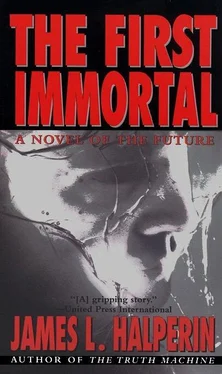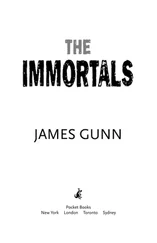Amazingly, the kid didn’t hesitate even a second. “Why sure, Mr. Smith. That’d be great. I’ve never known anyone who talks like you, dontya see? You’re like from somewhere else, real old-movie-like. Like old, old movies. Dontya see?”
That was when my message showed up on Ben’s corneal screen, informing him that I had to see him right away. He clicked his tongue once, our signal that he would arrive here in about an hour.
“Okay, Trip,” my great-grandfather said. “What’s so damn important you could only tell me about it in person?”
Virginia, Ben, and I headed toward the main conference room at our new headquarters of Neural Nanoscience Laboratories, the business partnership Virginia and I had formed back in 2084.
“They’ve discovered a way to replicate human beings,” I said as we seated ourselves at a sound-preclusion console near the door.
“Is this another one of your jokes?” Ben asked me, probably remembering the time I’d programmed micromachines to reposition furniture in his office whenever he glanced at his deskscreen. “Y’know, some Frenchman already beat them to it,” Ben added. “About sixty-two years ago.”
“No,” Virginia explained, “not just biological cloning; we’re talking about entire adult human beings, including memory and environmentally induced personality.”
“You’ve got to be kidding.”
“No, we’re not.”
“And right now we’re the only facility on the northeast coast of America with the necessary equipment and training,” I added. “We should have a monopoly for several months.”
Ben stared at us. “But how?”
“Ever since the Nemesis discovery, human scientists have been feeding all sorts of crazy projects to the AI banks,” Virginia explained. “Of course, some of them were bound to bear fruit. And last week, at the suggestion of about thirty nanoscientists, including Trip, the entire World AI Network spent four days calculating a safe way to upload data from human brains using nano-disassembler/assemblers. To put it in layman’s terms, we survey the position of every molecule in the brain, with some shortcuts, then store the information digitally in datacubes. That way we can transport it. Maybe transmit it all by radio, microwaves, or even infrared. Duplicating the body itself’s simple, of course; all we have to do is replicate a single cell’s DNA and clone it. But not until the memories are attached would you have the entire person.”
“And probably,” I said, “after a few thousand people have gone through the process, AIs can learn how to analyze what every neuron molecule means ; the way each molecule’s position and makeup translates into information.”
“A radical leap in technology,” Virginia said, “with, if you’ll pardon the pun, mind-boggling implications.”
“Such as?”
“We think we’ll be able to implant specific knowledge without disrupting memory. It could eventually lead to AIs being incorporated inside our brains, maybe linking our thoughts to the minds of others via transducers and radio signals, a sort of artificial telepathy. Someday, people might even choose to give up their bodies entirely in favor of nearly unlimited, machine-enhanced intelligence and physicality; to live their lives in ways we can barely imagine.”
“Maybe even safe from cosmic disasters,” I gushed.
Ben ignored me. “Why would anyone want a duplicate of themselves, though?” he asked Virginia. “Would such replicas be human? And more to the point, would they still be the same individuals?”
“Those are interesting questions,” she said, “but maybe more about semantics than science. For example, are you the same person you were ten years ago? Or the same person at age sixty that you were at ten? Arthur Clarke, the science fiction writer, once said the reason he decided not to be frozen was that he became a different person every ten or fifteen years anyway. Do you agree with that?”
“Well, you’ve taken his statement out of context, but in what you’re saying, absolutely not. It’s ridiculous. Even in context, he was wrong, but explaining it would take a four-hour dissertation.”
Virginia smiled concurrence.
Ben went on: “If you subscribe to that theory verbatim, why study in high school or go to college? Why learn anything you can’t use right away? Why invest your money for the long term just so ‘some other person’ can spend it? No, I believe I’m essentially the same human being I always was.”
“Good. I do, too. Okay, then what if you had partial amnesia? Or total amnesia?”
“Now I’m not so sure. Of course, I’d still have the same face and natural body-type, maybe the same personality…”
“Yes,” she said, “but so do clones, or identical twins, and we agree that they’re not the same, right?”
“I see what you mean.”
“Now let’s say we transplant your brain into my skull and vice versa. You inhabit my body and I inhabit yours. Which one am I?”
“You’d be the one in my body,” Ben said.
“Yes, I agree,” Virginia said. “It might even be fun to try someday, but I digress. Now here’s an interesting riddle: Suppose we learned how to duplicate parts of the brain mechanically, and begin to replace your brain at the rate of, let’s say, one percent per year. You don’t actually notice it happening, and your function and memory remain unchanged. After a hundred years, your brain becomes entirely mechanical, yet your personality and recall are the same as they were before. Are you still the same person?”
“I say: yes,” Ben declared.
“Okay then, what if you did it in a hundred seconds instead of a hundred years?”
“I’m not sure it would matter, would it?”
“Depends on your perspective. But so far, it seems you agree that information constitutes identity.”
“Maybe, maybe not. Okay, Virginia, I have one for you. Let’s say we construct your perfectly analogous mechanical brain, but keep the old biological one intact, too. I think most people would agree that the biological brain is the one that holds that person’s identity. Yet the only real difference between my example and yours is the continued existence of the biological brain. So why should the mere existence of the original brain affect the identity status of the mechanical one? And do you think it would matter whether or not one brain were aware of the existence of the other?”
“Interesting supposition. Reminds me of one of Robert Ettinger’s identity ‘experiments.’”
“What’s that?”
“Well, back in the 1960s, Ettinger proposed that we imagine a synthetic brain that could not only replicate the exact function of a particular human brain, but also maintain a total, radio-controlled interconnection with it. Now assume we can use various parts of each, the synthetic and the original, and the corresponding part of the other brain simply lies dormant. You could decide to use, say, the artificial medulla oblongata, hypothalamus, and brain stem, along with all the other parts of your original brain. You with me so far?”
“Sure.”
“Okay. Now we start the experiment with a normal, fully conscious woman, and the machine brain switched off. But slowly we start disconnecting various parts of her brain and simultaneously activating the corresponding parts of the machine. She never notices any of it, yet when we finish, the machine controls her body. Does she really become the machine?”
“I don’t know. It’s pretty confusing.”
“Wait. It gets worse. Now assume the machine has its own sensory apparatus. And whenever we want to, we can also cut off the woman’s senses, simultaneously activating the machine’s. In other words, we can cause her senses to switch from one body to another, woman’s to machine’s.”
Читать дальше












